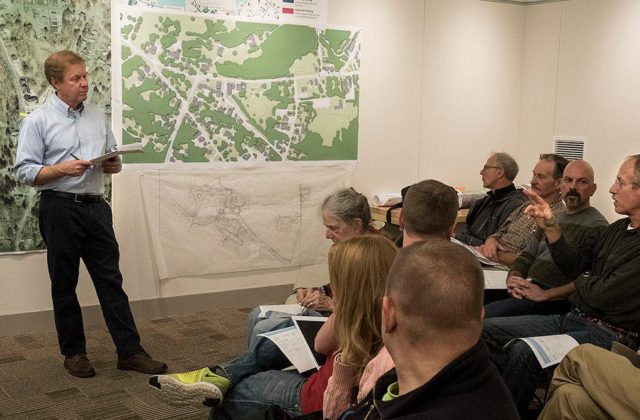Collaborative Workshop on Downtown Design Holds Final Meeting
Suggestions will be added to new town plan
By Wiley Wood
Photo by Bruce Frisch
As winter closes in, most Norfolkians will limit their interactions with the town center to the few yards of sidewalk between their parked car and the post office or library. In the summertime, a person might take a more expansive view of the town’s offerings—nip up to Town Hall to ask about a dog license, amble to the village green to see if the Historical Society is open, or wander down to City Meadow to check on bird activity.
If this sounds unlikely, a group in town has been working to make it less so, meeting regularly with Peter Flinker of the landscape architecture and planning firm Dodson & Flinker to brainstorm about design improvements that might make the Norfolk town center more inviting and accessible.
At a Nov. 4 meeting at the Norfolk Hub, Flinker invited his audience to think of the village center as a campus, with all the ease of movement along interconnecting paths and roads, linking a diversity of buildings and facilities, that the term suggests.
The discussion of traffic and parking, acknowledged problems in Norfolk, began with the question of whether to make Station Place and John J. Curtiss Road a one-way thoroughfare. The difficulty and danger of making a left turn out of Station Place onto Route 44 were cited in favor of the change, while the blind intersection at Curtiss and Shepard Roads was cited against it. A show of hands indicated that a majority of those in the room favored making the street one-way.
Flinker emphasized that the discussion at this stage is largely conceptual, and that the vote was intended mostly as a reading of whether further study of the question is in order. Cost, feasibility and advisability will have to be carefully weighed before any changes are made. The suggestions arising from Flinker’s collaborative workshops or “charrette” will be incorporated into the next town plan.
A second question was whether a road should be built from Station Place to the Town Hall parking lot, following the course of the present footpath. Flinker pointed out that this would allow a driver arriving in Station Place to head up to Town Hall if there was no parking available below. Doubt was expressed about whether this would enhance the campus feel of the downtown area, and a show of hands went against the idea.
Slowing traffic on Route 44, particularly near the village green, has long been a goal of town residents. Flinker proposed a roundabout on Route 44 at the intersection of Route 272, cutting slightly into the edge of the green. Setting aside the question of whether the Connecticut Department of Transportation would cooperate, a majority of the participants expressed doubts about the idea.
Matt Riiska reported that the DOT had recently made a study of traffic on Route 44 near Botelle School. They found that vehicles went downhill past Botelle at an average of 46 mph and uphill at an average of 43 mph. They considered a reduction of speed there to 35 mph an insufficient change and planned no action.
Among the other topics discussed was the possibility of bringing the Ellen Battell Stoeckel Estate more closely into Norfolk’s downtown orbit, perhaps with pathways linked to the village’s larger pedestrian network. The estate’s director of operations, Jack Beecher, said it would be a challenge but that it wasn’t completely off the table.
He explained that the Battell Stoeckel Trust had invested $6 million in the last four years to improve the buildings on the estate and would likely have to spend another $10 million in the years ahead. There simply wasn’t money to maintain roads and pathways beyond what was strictly needed for the program.
But he said that the trustees were not opposed to the concept, if a way could be worked out between the town and the estate that did not increase the trust’s liability or expenses.
Looking at the lengthy list of proposals generated by the charrette, Kim Maxwell, a Norfolk resident, suggested that the town choose three or four things that don’t cost a million dollars and get them done. “The town changed a lot when the store came,” he pointed out.
A draft of the new town plan, or Plan of Conservation and Development, will be presented to the Planning and Zoning Commission on Nov. 29 and submitted to town residents for approval at a public hearing next spring.

